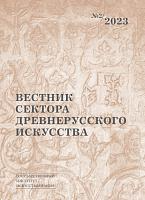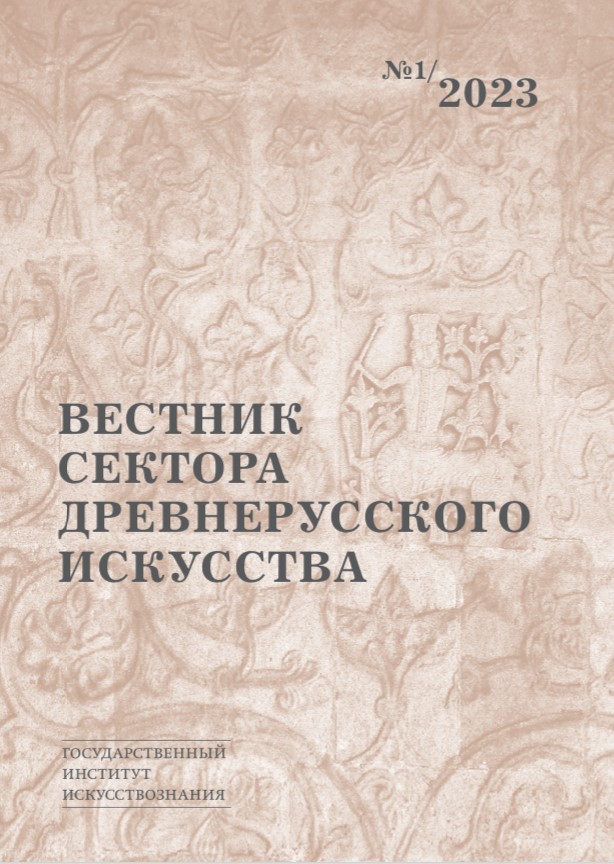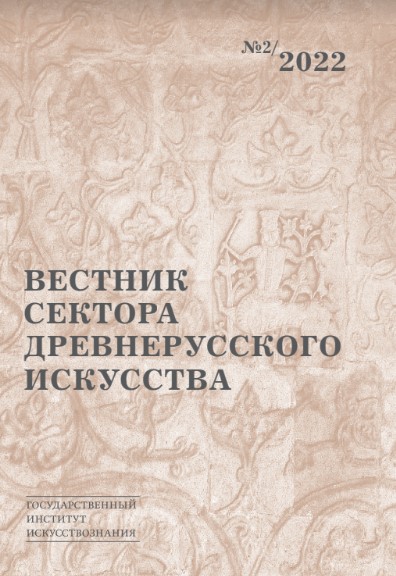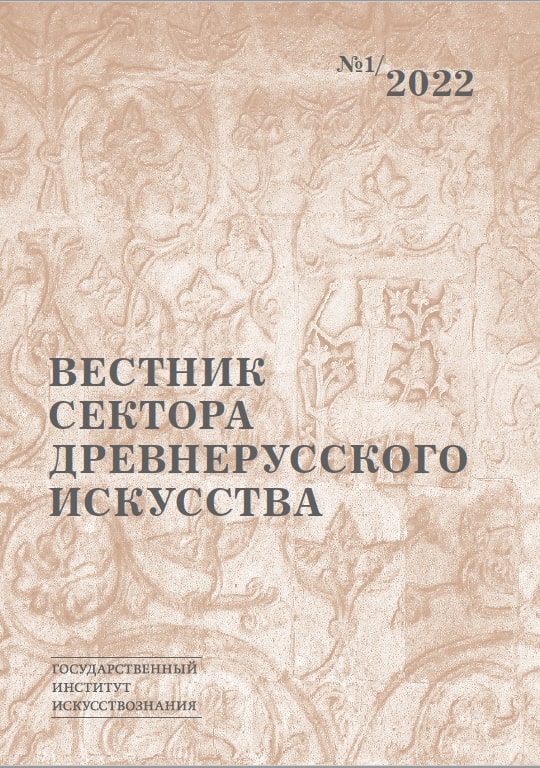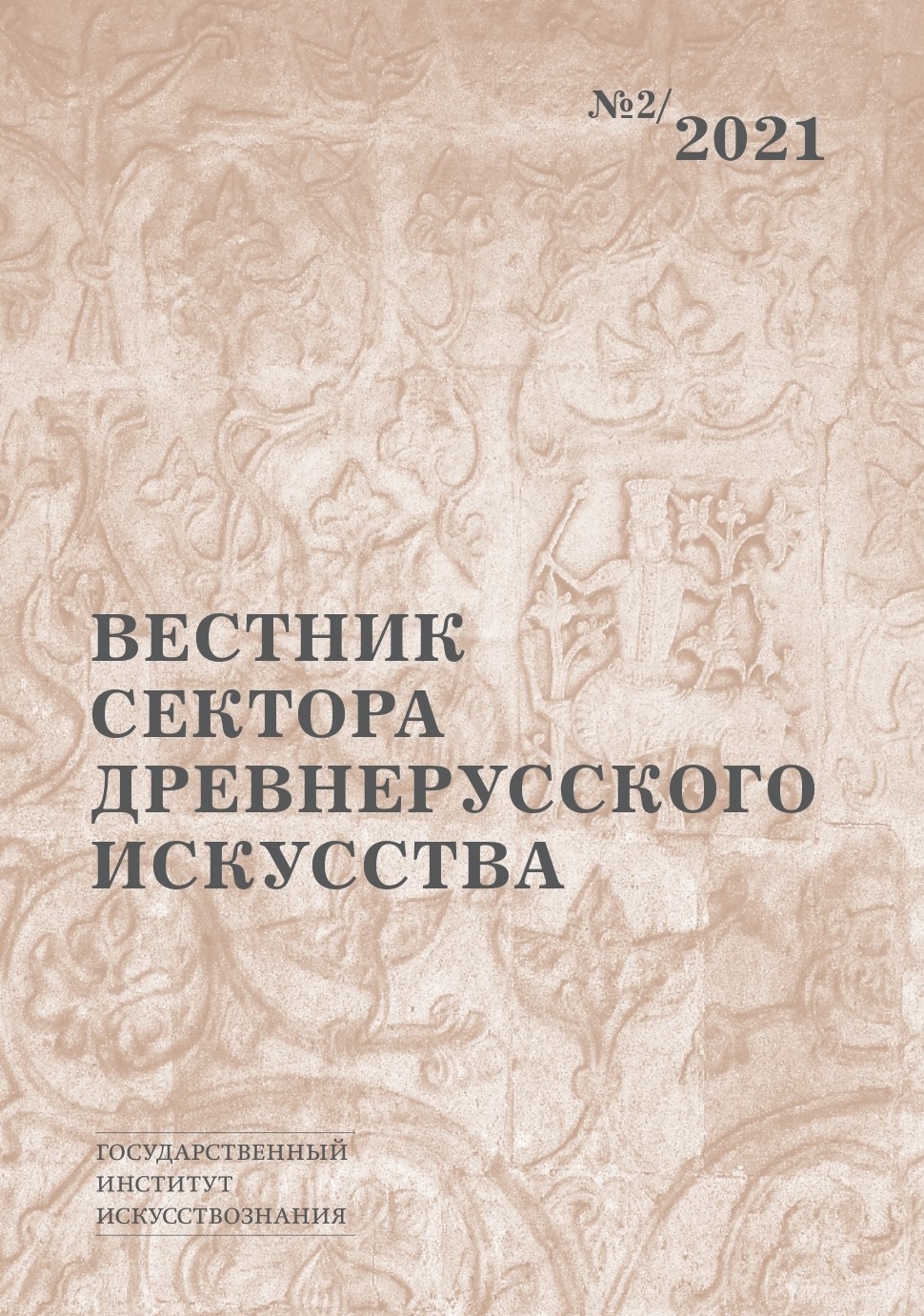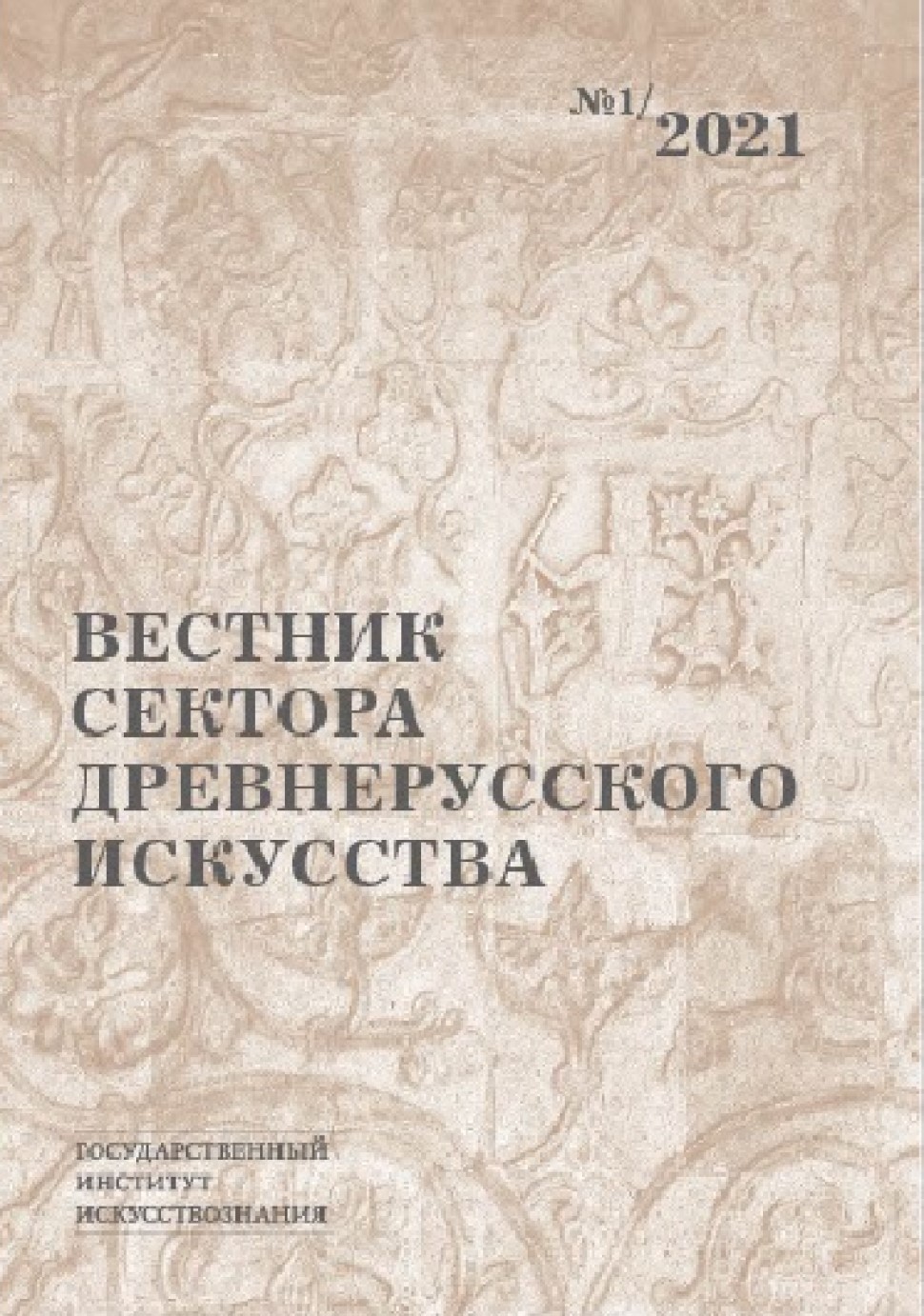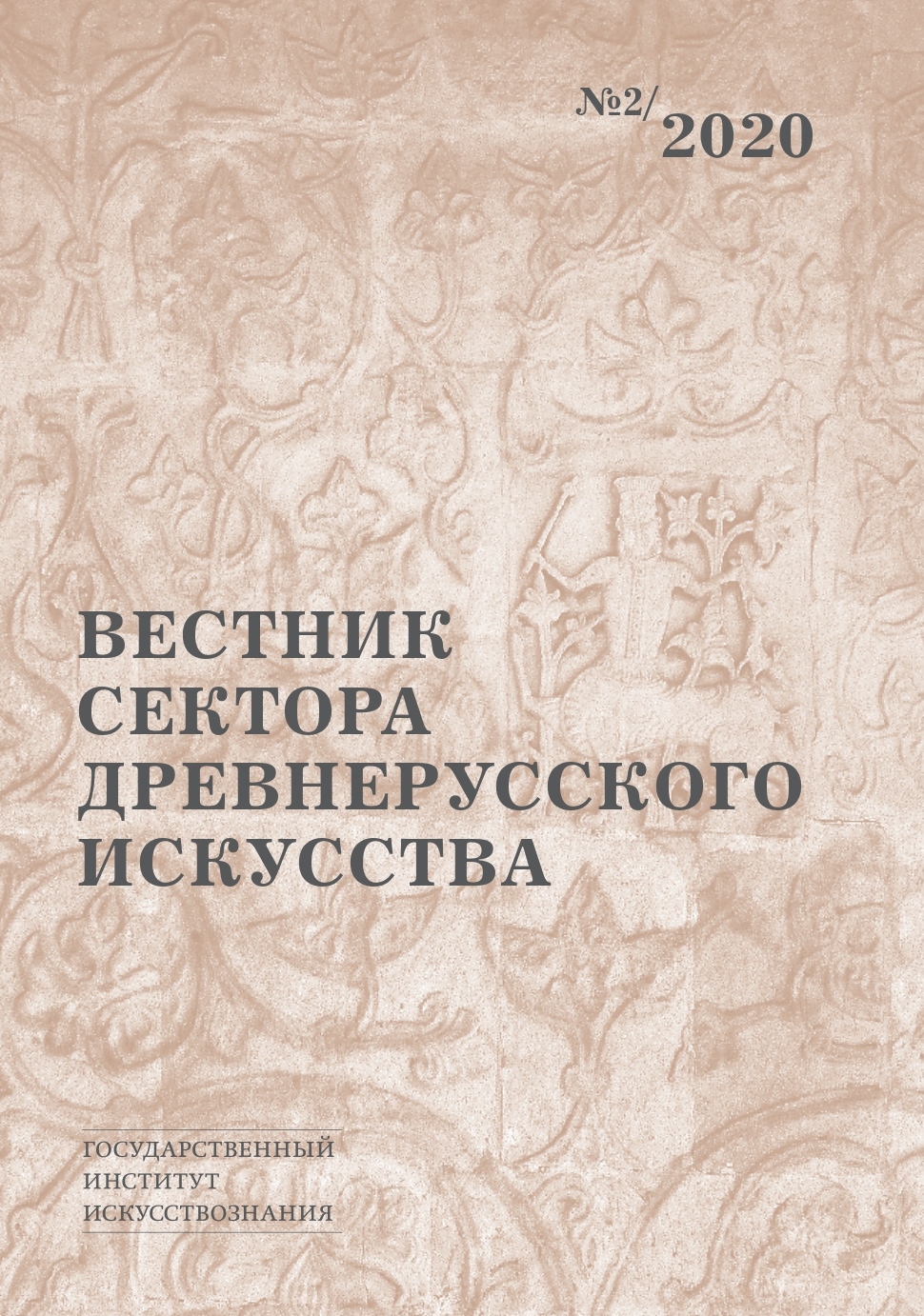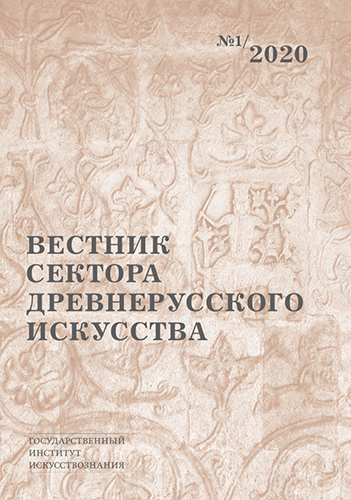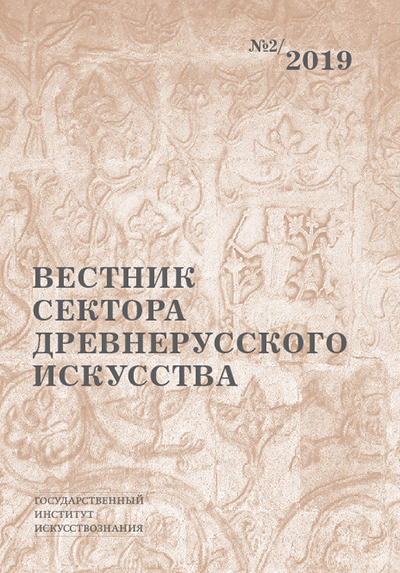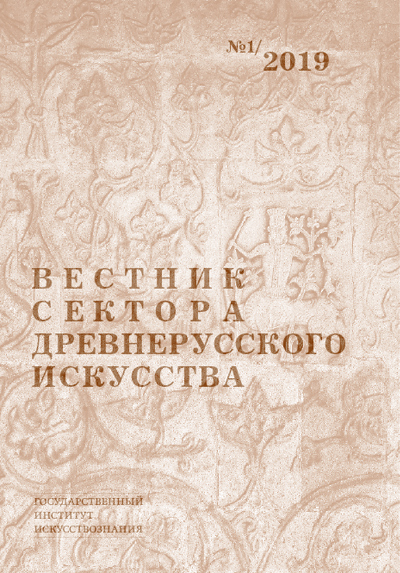2021 ¹ 1
Articles
Irina Sterligova. About the Ancient Cloisonne Enamels with Sacred Images Created in Russia
Abstract
Attributions of cloisonné enamels with images of Saints Irina and Barbara from the Staroryazan hoard of 1822 among the works of Old Russian painting of the second half of the 11th century.
Keywords
Old Russian cloisonné enamels, problems of research, technological and stylistic features.
Abstract
The paper deals with some aspects of the technology and technique of the main fresco ensemble of the Transfiguration Church, created by order of St. Euphrosyne of Polotsk. In our opinion, the stylistic features of the painting point to the middle of the 12th century as for the time of its creation. However, there is no consensus among art historians on the dating of the architecture and wall paintings of the Church of Our Saviour. Full-scale surveys of the church, which have been conducted in recent years, confirm the previously proposed thesis that there was no gap between the construction and the execution of the painting. The paper presents data on the specific use of plaster markings by the painters in Polotsk, as well as the preparatory drawing.
Keywords
Art of the Byzantine world, painting of the middle Byzantine period, fine art of Old Russia, monumental painting of the pre-Mongol period, frescoes, wall painting technology and technique, Church of Our Saviour, St. Euphrosyne convent, Polotsk, 12th century.
Inna Mokretsova.Initials of “The Bardewik Codex” (1294)
Abstract
The collection of laws of the city of Lübeck of 1294, the so-called Bardewik Codex, unlike other books of the city law of the Hansa, is richly decorated with initials that open each article. 237 initials, the ornamentation of which differs both in drawing and in the variety of combinations of saturated colors which lie on a gold background, were apparently executed by several artists of the city atelier after the scribe's work was completed. The article is devoted to the description and classification of the code’s initials. Analogies to decorative motifs can be found in the design of monuments of pre-Romanesque, Romanesque and Byzantine art: these are spirals, five-petal Byzantine crines, hearts, palmettes, braids, arabesques and others. The upper and lower ends of elongated ornamental stripes are often completed with Gothic motifs of a cross, spitz, phial, cones, cruciferous, tripolia (more than 30). The extensive and diverse ornamental repertoire of the Bardewik Codex makes it a unique piece of book art created by a group of urban artists.
Keywords Medieval illuminated manuscript, German manuscripts, ornament, initials, parchment manuscripts conservation.
Abstract
The article is devoted to the stone buildings of the Moscow Kremlin Chudov Monastery of the 14th–16th centuries — the churches of the Miracle of Michael the Archangel at Chonae and Alexius the Metropolitan. The author offers his own version of the chronology of their construction and alterations in this period, different from the previously established ones. In addition, an attempt is made to reconstruct the circumstances of the acquisition and transfer of the relics of Metropolitan Alexius during the 15th century, directly related to the construction history of the Chudov Monastery.
Keywords
Moscow Kremlin, Chudov Monastery, Metropolitan Alexius, architecture of the 14th–16th centuries, monastic churches of the Miracle of Michael the Archangel at Chonae and Alexius the Metropolitan.
Abstract
The presented paper is the first half of the article devoted to the problem of dating architectural structures by methods of archeology and epigraphy. It demonstrates some errors in the work of restorers, which damage the authentic remains of original structures and make it difficult to date them. An example is the catholicon of the monastery of Peter the Metropolitan in Moscow. Its date within the 1510s is established due to a full-scale study. Also, with the help of archeology, it was possible to restore the history of the construction of the church in the 17th century. However, during the last restoration, some of the masonry was destroyed. It is proposed to clarify the dates based on the surviving tombstones of the 16th– 17th centuries that were used for the second time. The characteristics of these slabs and the reading of their inscriptions are given.
Keywords
Late medieval archaeology, history of architecture, chronology, methods of the research and restoration, cemetery, tombstones, epigraphy.
Abstract
St. Trinity Antony-Siya Monastery was founded in 1520 not far from the Northern Dvina River entry. Old Testement Trinity icon was painted in 1538 by Saint Antony (1478–1556), the founder of the Monastery. The first wooden Trinity Cathedral at the Monastery burnt down but the Trinity icon was saved. Lots of miracles, connected with this icon, are described in St. Antony of Siya hagiography. It was placed above the reliquary with his remains and decorated with a jeweled frame, presented by Patriarch Filaret.
Keywords
Icon, icon painter, Siya monastery, church, Holy Trinity, culture of the Russian North
Abstract
Soon after 1558 the established “duo” of the Novgorod saints Nikita and John were added to the ancient image of Sophia the Divine Wisdom (in the so-called Novgorod izvod), which decorated one of the niches of the “cell of John” in the Bishop's Chamber of the Novgorod Kremlin. Over the following centuries the fresco underwent repeated updates. The article examines the stages of these changes based on the analysis of changes in the iconography of St. Nikita. A fragment of another image near the niche with this fresco is reconstructed as part of the figure of St. Euthymius the Great — the heavenly patron of the builder of the chamber, Bishop Euthymius of Vyazhishchi. In later updates, this figure was identified with the archbishop himself. In fact, the figures of Holy Novgorod bishops grouped around the image of Sophia the Divine Wisdom both in the “cell of John” and on other monuments around the middle of the 16th century, not only capture an important stage in the formation of the Novgorod pantheon of holiness, but also reflect the social and state ideas of the 1560s, which guided the policy of Novgorod in an effort to demonstrate their loyalty to the centralized secular power of Moscow.
Keywords
Monumental painting, fresco, St. Nikita of Novgorod, St. Ioann (John) of Novgorod, Evfimy II, Archbishop, the Episcopal Chamber (Chamber of Facets), iconography, Veliky Novgorod, Old Russian art, restoration.
Irina Shalina, Viktor Baranov. Attribution of a Rare 16th Century Two-Sided Tablet-Icon
Abstract
The article is devoted to the attribution of the tablet icon “Theophany — The Synaxis of John the Baptist” (22.7 × 19.1) from the Museum of the Russian Icon. It has undergone a comprehensive study at the State Research Institute for Restoration, which revealed some features of artistic execution, the degree of intermittent interventions, and the painting technique. The unique iconography of the tablet which combines the feasts dedicated to John the Baptist, allows us to talk about a significant series of icon calendars, thus reflecting the formation process of the iconography of the Synaxis of John the Baptist (January 7) in Russia. By its specific technique of execution, artistic style and iconography the icon can be connected with the Pskov art of the 1540s.
Keywords
Old Russian Art of the 16th century, tablet icons, series of proskinesis ikons, iconography of the Epiphany, iconography of the Synaxis of John the Baptist, Pskov.
Abstract
The article is devoted to the construction date of the church of the holy martyr Antipas of Pergamon at the Great Stables. The resemblance of the Moscow buildings of the late 1540s, the cathedrals of the Moscow Simonov and Novodevichy monasteries, as well as the cathedral of the Kirzhach Annunciation Monastery allow the church to be dated to the late 1540s — 1550s. The peculiarities of the interior, the profiling of parts, as well as the size of small bricks all point to the same period. According to the peculiarities of the composition, the church of the Holy Martyr Antipas can be placed next to the cathedral of the Moscow Danilov Monastery (1561), which may also have had a crown of multi-row kokoshniks. Both churches belong to the architectural tradition, formed in the monastery construction in the middle of the 16th century and associated with the construction of four-pillar buildings, which mainly have a ceiling structure in the form of raised supporting arches. The Church of the Holy Martyr Antipas has a special place in the typology of churches with a groin vault of the beginning — the second half of the 16th century, which are mostly covered by trifoils.
Keywords
Russian medieval architecture, the middle of the 16th century, pillarless temples, a groin vault, undersized bricks.
Iuliia Buzykina. Saints of Rostov the Great in the Wall Paintings of the Archangel Cathedral
Abstract
The paper deals with depictions of the holy bishops and monks of Rostov the Great in the system of the wall paintings in the cathedral of the Archangel of Moscow Kremlin. The saints of this city, which is one of the oldest Russian cathedrae, establish the ancientness of the Russian church as an institution and the role of secular authorities in the expansion of the Orthodox Christian Faith in Russian and Tatar lands.
Keywords
Moscow Kremlin, Cathedral of Archangel, Russian Medieval art, Russian wall paintings, Russian Art of 17th century, Russian saints, Rostov the Great.
Abstract
The article is devoted to the analysis of well-known works of Old Russian silversmithing — the shrines of Russian Miracle-workers. Author devotes much attention to the fragments of the shrines of Ss. Alexander of Svir, Cyril of Belozersk, Paphnutii of Borovsk, Sava of Zvenigorod and examines the archival and figurative sources relating to their making, construction and their reworks. Author suggests a new date of the shrines of Ss. Alexander of Svir and Cyril of Belozersk. For the first time publishes the texts of the inscriptions situated on the walls of the shrines of St. Cyril of Belozersk. Research is founded on documents of archives of Armory for the first time used in the scientific literature.
Keywords
Shrine, embossed tombstone, Silver chamber, Alexander of Svir, Cyril of Belozersk, Paphnutii of Borovsk, Sava of Zvenigorod.
Chronicles
Restoration chronicles
Exhibitions
Iuliia Buzykina. Russian Field of Experiments. Exhibition I, Protopop Avvakum, Do Thus Believe…
Iuliia Khod'ko. Visscher’s Theatrum Biblicum of 1643 from the Tretyakov Gallery. Moscow, 2020
